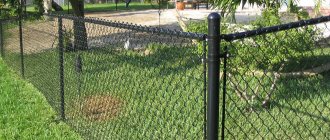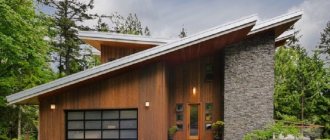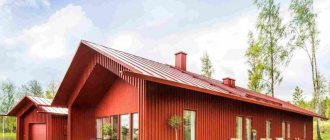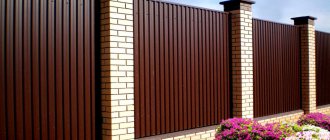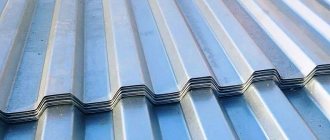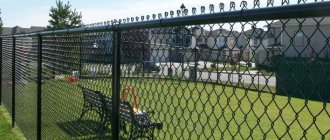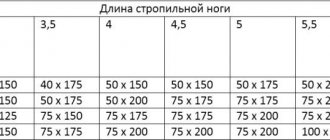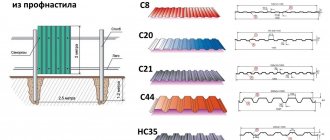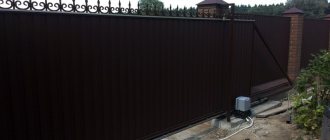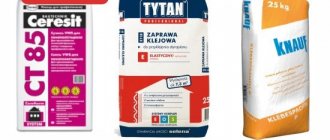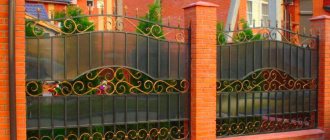Fencing made from corrugated sheets is distinguished by durability, speed of assembly, and aesthetics. Because of these advantages, it has gained popularity when arranging dachas, country houses, and private sector estates. But to install a high-quality structure, you need to be able to properly attach the corrugated sheet to the fence. This assembly stage has important points, which we will discuss in this article.
Features of fastening corrugated sheets depending on the material of the pillars
Before purchasing corrugated sheets, you should select the raw materials, type of coating, and color in advance. In addition, you need to calculate the number of sheets and fasteners for them. You will find detailed recommendations for choosing sectional material here:
- What kind of corrugated sheeting is used for fences
- Fence made of metal siding under timber
After this, you can begin construction. Having determined the location and completed the markings, they form supports for the future fence. The method of attaching the corrugated sheet depends on what material they are made of.
Brick
Creating brick pillars is a labor-intensive, long and expensive process due to the high cost of the material. But ready-made supports do not require additional finishing, and if masonry technology is followed, they will last for decades.
Article: laying pillars for a brick fence
They screw the corrugated sheet onto the fence with such posts not onto the brick, but to special metal lintels.
Tree
Inexpensive option for supports. The frame is assembled quickly, so you can easily handle it alone.
But builders do not recommend using wood as posts for a permanent fence made of corrugated sheets. Even with careful care, the fence is unlikely to last more than 5–8 years. It is better to install such racks under temporary fences.
We recommend reading the article: “Installation of wooden fence posts.”
To properly attach corrugated sheets to wooden posts, you must first fix the metal corners and then use self-tapping screws. An alternative is to immediately mount the sheets to the joists with self-tapping screws, but this option is inferior in strength to the first.
Metal
The most reliable type of supports for corrugated sheets.
The only caveat is the need to coat the poles with an anti-corrosion solution to protect the metal. For aesthetics, it is recommended to paint the support. An article about the procedure for installing metal poles.
There are two ways to attach logs to racks:
- Welding. The crossbars are welded strictly horizontally between the posts or in front of them on the street side of the fence. The frame is more rigid and stable in the first case.
- Cross-shaped brackets. They are plates with curved edges that are attached to the joists with self-tapping screws. This option does not require welding.
If you have no experience in welding, then it is better to use the second type of installation.
What do you need to know to attach corrugated sheets?
Thanks to such material as corrugated sheeting, in a fairly short time you can create a quite attractive and fairly reliable fence, roofing or facade structure.
Installation diagram of a fence made of corrugated sheets.
That is why you should learn more about which fasteners to choose for corrugated sheets, how fasteners are calculated and what nuances there are that should be taken into account.
Speaking about the correct fastening of corrugated sheeting, it is necessary to place special emphasis on the simplicity of this fastening and the minimum set of tools that will be required. The material itself is quite economical. Only a minimum of costs will be required to cover even large areas.
Methods for fastening this material and fastening elements for corrugated sheeting are selected based on the type of work process:
- finishing the fence;
- roof installation.
Corrugated roofing diagram.
It is useful to know that corrugated roofing sheeting can withstand the heaviest loads, because a special reinforced shape is used in its manufacture. In this regard, reliable protection of the entire space under the roof and, accordingly, any room inside the structure is ensured.
All this has a positive effect on the popularity of profiled sheets that are used for roofing. There are other factors that contribute to the great growth in popularity of this building material:
- extraordinary convenience and simplicity of the work process;
- high strength indicators;
- ease of handling materials for construction;
- light weight of the material.
Due to the fact that this material is light in weight, there is no need to strengthen the supporting structure before attaching the corrugated sheet to the roof. This contributes to a significant reduction in roofing costs.
Even a person who has absolutely no construction skills or special experience in matters related to construction can, if desired, attach corrugated sheets. In addition, this material is quite easy to cut and screw to most existing bases. Even severe frosts cannot interfere with installation, which can be considered as an additional advantage.
Items needed:
- several types of screws;
- corrugated sheeting;
- clamps;
- welding machine;
- screwdriver;
- sealant;
- jigsaw or metal scissors.
Sheet fastening schemes
Below are diagrams of the correct installation of corrugated sheeting to metal and brick pillars, an example of installation of sheets when creating gates, wickets, photos of fastening the material when the fence is on a slope.
We select reliable fasteners
There are several ways to fix sectional material to the fence frame:
- self-tapping screws;
- bolts and nuts;
- rivets;
- welding
Let's look at the features of each of them and determine the most reliable one.
Self-tapping screws
To secure fence sheets, roofing screws (hardware) are often used. They are made from steel type C1022, which is highly durable and has a protective anti-corrosion zinc coating 15 microns thick.
Photo: color scheme of roofing screws
They consist of 3 parts:
- Drill. Using it, the element is screwed into the corrugated sheet.
- Rubber gasket under the press washer. Located under the cap itself. Ensures the tightness of the fastener and prevents moisture from penetrating the sheets at the points of fixation.
- Heads (hats). It is covered with a durable layer of polymers, due to which the self-tapping screw becomes resistant to environmental influences. The colors are different and matched to the sectional material. This way the hats become almost invisible against the general background of the fence. Shapes – round, hexagonal, cylindrical, semicircular.
Hardware is produced with a diameter of 4–6.5 mm and a length from 19 to 250 mm.
It is most convenient to screw in the screws with a screwdriver.
Photo: the process of attaching corrugated sheets to joists using a screwdriver
To calculate the required number of elements, you need to divide the total area of the sheathed fence (including overlaps) by the area of one sheet. Builders recommend doubling the number of hardware near the ends for greater fastening strength.
The average consumption of self-tapping screws is considered to be 8–9 pieces per 1 square meter. m.
When screwed in, the fastening element must be strictly perpendicular to the sheet without distortion.
To assemble fence sections, it is allowed to use hardware for metal tiles.
Bolts
This fastening method is as strong as self-tapping screws.
Photo: securing sheets to the profile using bolts. You should first drill holes for the diameter of the bolt.
In addition, if the hardware can be easily unscrewed with a screwdriver and penetrated into the fenced estate, then the bolts can only be removed from the inside of the yard. But their price is several times higher than self-tapping screws, and the color range is limited to black and silver, which significantly sets them apart from the general sectional covering.
It will not be possible to do the fastening work using this method alone, since the sheet will have to be attached to the frame in advance, mark the hole for the bolt, drill it, and only then fix the corrugated sheet to the joists.
The average norm for 1 sheet is 4 pieces.
Rivets
Provide a strong connection between the corrugated sheet and the fence frame. Consist of two parts made of different metals:
- hats made of aluminum;
- legs made of steel.
Hats are:
- colored;
- unpainted.
Diameter – from 3.2 to 6.5 mm. Fastening is carried out using a rivet gun.
Photo: metal rivet for a manual rivet gun
The average consumption of elements is from 6 to 8 pieces per 1 sq. m.
With this method of fixation, you do not need to drill through the profile to get a strong connection; it is enough to make a hole in only one side of the joist.
When choosing rivets, it is important to consider the weight of the sectional material. The larger the diameter of the rivet, the stronger the fastener.
You also need to pay attention to the length of the purchased elements. It should be selected so that the tip of the rod is visible above the fixation site by at least 10 mm. It will not be possible to achieve this with a lower rigidity index.
Rules for choosing corrugated sheeting for a fence
When choosing a material for a fence, you must take into account the following characteristics:
- Scope of sheets.
- Surface coating.
- Sheet size.
- Wave height.
- Color of polymer coating.
Corrugated sheets
According to the type of application in construction, sheets can be roofing and wall. Both are suitable for a fence, but roofing ones will cost much more.
All profiled sheets are produced from galvanized sheet steel using the cold rolling method. Subsequently, they can be coated with a layer of polymer paint. Unpainted galvanized sheets are much cheaper, but their service life is short - 5-10 years. Zinc coating is susceptible to corrosion when exposed to air and moisture. Painted and polymer-coated sheets can last several times longer.
The width of the sheets according to GOST 24045-2016 can be 750 mm or 848 mm (this is the useful width, taking into account the overlap of the corrugated sheet on the fence in one wave). It is believed that one wave is used to join the sheets together. The length of the sheets, which determines the height of the future fence, can vary from 50 cm to 1.2 m. Sheets longer than 3 m are usually produced and delivered to stores to order.
Dimensions of roofing and wall profiled sheets
The wave height of the produced profiled sheets can be any in the range from 8 mm to 21 mm. The larger this parameter, the greater the rigidity of the sheet, which means it better resists the wind. The optimal value for use in the construction of fences is considered to be a wave height of 15 mm with a sheet thickness of 0.5 mm.
The color of the coating is selected depending on the site development project, the appearance of the buildings and landscape, as well as the personal preferences of the site owner.
Why you shouldn't use welding
Craftsmen do not recommend installing sheets by welding due to high temperatures. Accidental thermal exposure will destroy the protective layer of corrugated sheeting and lead to further corrosion of the material, and in the absence of experience, you can completely deform the section or make a hole in it.
If the fence is needed as a temporary structure and quickly, then all welded metal elements are cleaned, treated with an anti-corrosion solution and painted.
How to properly attach corrugated sheeting to the roof?
Schemes for planting screws.
You need to know the main steps that must be followed sequentially in order to correctly attach corrugated sheeting to the roof of an existing house.
First of all, the profile sheets are laid out in the required order so that the amount of overlap of the profiled sheets depends on the existing roof slope angle (the greater the slope, the less overlap is necessary). The largest overlap will be approximately 20 cm and can be selected for a roof slope that does not exceed 15°. However, when the slope exceeds 30°, the overlap will automatically decrease to 15 cm.
If the roof slope is critically small (less than 10°), additional sealing of the sheet floors must be performed.
Next comes the installation of the sheathing. The size of this element should be selected based on the roof slope angle and the wave height of the corrugated sheeting (the greater the wave height and roof slope angle, the larger the pitch for the sheathing should be selected). In addition, these indicators will influence the number of waves that the overlap includes. When the roof has small wave heights or a small slope, the overlap must necessarily include at least 2 waves.
Next is the fastening itself. You should know that the profile sheets that cover the entire length of the roof slope are fastened with self-tapping screws parallel to the roof eaves.
When laying each subsequent row, an overlap of 20 cm must be observed.
Some nuances should be taken into account:
- self-tapping screws should only be screwed into the profile cavity of the corrugated sheet;
- ridge screws differ from roofing screws in length;
- When manually tightening self-tapping screws, the force applied must be correctly calculated so as not to damage the insulation layer and prevent loose tightening.
Connection methods and installation procedure for corrugated sheets
Performed in two ways:
- Butt. Each sheet is individually attached to the fence joists. Most often, the fastening elements are self-tapping screws in the amount of 5–6 pieces per 1 sheet. Additional screws are screwed at the bottom to increase strength. Mounting holes are pre-drilled. They should be slightly larger in size than the diameter of the screw. In places where the sheets join, flashings are fixed.
- Overlapping. The most durable installation method. The amount of overlap of the corrugated sheet is one wave (profile bending). The hardware is tightened until it fits tightly to the material. As in the first case, holes for self-tapping screws are drilled in advance, after which it is recommended to treat them with an anti-corrosion compound.
It is important to note that, regardless of the chosen method, holes for hardware are drilled strictly level, adhering to a straight line. This ensures smooth fastening of the sheets to the fence frame.
In addition, it is worth considering the following points:
- To speed up the assembly process, make marks with a marker or chalk at the points where the screws will enter the sheet.
- First you need to secure the edges of the corrugated board, check the verticality and then proceed to fixing the intermediate screws.
- If the logs are wooden and the hardware rotates during installation, then it is permissible to stuff a small sliver of wood into the fastening area.
- To cut sheets, use metal scissors or a jigsaw. It is not recommended to use a grinder. Sparks during operation of the tool damage the protective coating of the material, causing the sheets to begin to corrode.
Upon completion of installation, corner joints and ends of the material can be processed. It is better to cover them with a metal strip of the same color as the fence, placing them on hardware in increments of up to 30 cm.
Base for the fence
Initially, the ceiling line is marked, for which posts are installed in the required places and in the locations of large gates and wickets.
The role of supports is performed by metal pipes with a profile of 10 cm or more. This stage is very labor-intensive and important. Recesses with a depth of 1 m are prepared for the supports.
The pole support must be installed vertically; verticality is measured using a level. Afterwards, the depression is compacted by filling it with stone or crushed stone.
The height of the supports is determined by adding to the height of the fence 30 cm. The supports can be installed in several ways - combined, concreting, driving in and crushed stone.
Next, the foundation for the fence is prepared. Quite often, a fence made of corrugated sheets encloses only the street side, so you will need to prepare one side of the site or two if the house is located at a corner.
The most suitable option is a strip-type base, which will rise 20 cm above the earth’s surface.
The depth of its digging depends on the type of soil, but no more than 30 cm. Regardless of the presence of a foundation under the fence, the corrugated sheeting is installed just above the earth's surface, without contact with it.
Please watch the video on the topic:
After the concrete solution has completely dried, logs are installed, attached to the pole supports by welding or clamps. After assembling the frame structure of the fence, corrugated sheets are installed.
Installing the top decorative strip
The finishing touch to the construction of a fence made of corrugated sheets. A special strip is attached to the upper part of the structure with self-tapping screws. The color should match the fence.
Photo: corrugated sheet fencing with a welded strip
Its main purpose is to strengthen the strength of the frame and give the fence a finished look.
Compliance with the technology for installing corrugated sheets allows you to create a reliable fence with your own hands in a short time, saving money on ordering the services of specialists.
